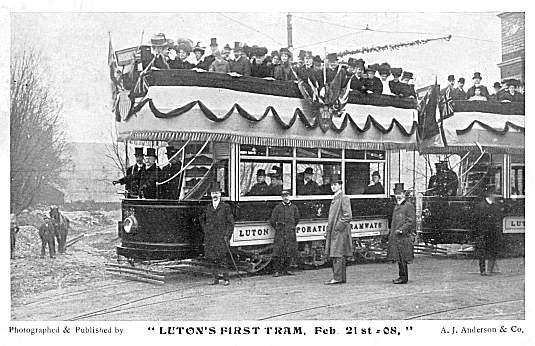

From photographer and publisher A.J.Anderson, we get this printed postcard with car 3 at the official opening of the Luton tramway on 21st February 1908. The enterprising publisher must have worked fast as our copy was posted from Luton to Dunstable on 27th February, just six days later. Posing at the controls of the tram is probably Mr. Gair Ashton M.P. (later Lord Ashton of Hyde) who opened the system, having stepped in after Mr. Howard Whitbread M.P. who was to do the opening and Lord Ampthill who was to assist were both taken ill with influenza.
Luton is a small industrial town in Bedfordshire about 30 miles north of London. Traditionally it was known for the manufacture of straw hats, but after 1905 became the home of Vauxhall Motors, commercial vehicles still being manufactured there today. After some years of discussion, work commenced on building a standard gauge tramway on 7th October 1907, the 5¼ mile system being completed and opened as a whole in just 4½ months. The tramway was owned by Luton Corporation but was built by J.G.White and Co. Ltd., who also as lessees operated the system for the next year, after which the lease was passed to Balfour Beatty & Co. Ltd. The routes initially were London Road (Tennyson Road) to Wardown (Bath Road), Park Street (Bailey Street) to Dunstable Road (Laundry) and Town Hall to Round Green (Stockingstone Road) via High Town Road, the routes all crossing the town centre and being mostly single track with passing loops. The fare was 1d with a 1½d transfer ticket available. The depot was at Park Street terminus.
The rolling stock was a batch of twelve standard open-top Preston cars supplied by the United Electric Car Company Ltd. They seated 22 on the lower deck and 24 on the upper. They were mounted on Mountain & Gibson 21EM 4-wheel trucks, each with two BTH GE54 29 horsepower motors controlled by BTH K10D controllers. In 1923 a single deck car was bought from Glasgow Corporation, this having been previously cut down from electrified horse car 118. The Luton livery was grass green and ivory, with the fleet name in outlined deep yellow.
In 1923 the corporation took over the operation themselves. Falling traffic caused them to buy the second hand single-decker mentioned above, which was used on the Wardown route as a one-man car. In 1929 cars 1, 2, 4 and 5 were given Brush top covers. At the end of 1930 the Eastern National Omnibus Company offered to buy the tramway and replace it by motor buses. This was accepted by the corporation but following local opposition, the Minister of Transport failed to sanction the transfer. Instead, the corporation replaced the trams themselves by a small fleet of their own deep maroon motor buses. Trams were withdrawn on 28th February 1932 on three routes just leaving the Round Green to Depot route, operated by three trams plus one in reserve, which continued until 16th April 1932. At 11.30 p.m. on that night, without any ceremony, car 7 ran into the depot for the last time and the tramway closed. The corporation continued with its own motor bus services until January 1970 when they were sold to the United Counties Omnibus Company (now part of Stagecoach).
![]() Go to Postcard Of The Month Index
Go to Postcard Of The Month Index